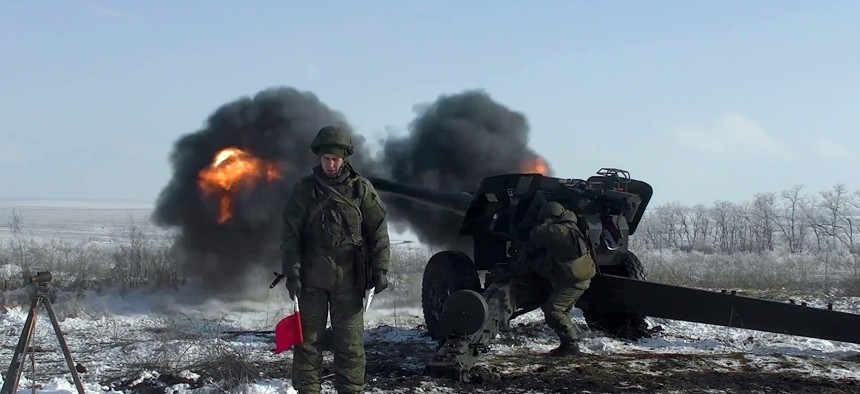
Russian servicemen from the units of the 150th Motor Rifle Division of the Southern Military District take part in exercises on the training grounds in the Rostov Region, Russia, near Ukraine, on January 28, 2022. Russian Defence Ministry / Handout/Anadolu Agency via Getty Images
The Russia-Ukraine Crisis Need Not Spiral Into War
Small diplomatic steps are pointing the way toward compromise.
Peruse the coverage and commentary on the Russia/NATO crisis in the country’s most prominent newspapers and you might conclude that the Russian military juggernaut will soon trample diplomacy by marching into Ukraine and overturning the European security order.
One member of President Donald Trump’s National Security Council staff opined that attacking Ukraine is President Vladimir Putin’s opening move in a gambit to “evict” the United States from Europe. Another Trump staffer warned of a Europe-wide war that would start with an “almost certain” Russian assault on Ukraine, draw in NATO, and create Europe’s worst calamity in 80 years. In some renditions, Putin plays Hitler to Biden’s Neville Chamberlain. Diplomacy is a fool’s errand.
Oddly, in Ukraine—the country facing 100,000-plus Russian troops—the mood is rather different. President Volodymyr Zelensky and his defense minister, Oleksii Reznikov have urged an end of the war hype. They don’t see a Russian attack as imminent; a political solution remains possible. Reznikov expressed his readiness to meet his Russian counterpart, Sergei Shoigu. Meanwhile Russia’s news agency, TASS, stated that Putin is open to receive Zelensky in Russia for talks.
Yes, the talks held between Russia and the United States, NATO, and OSCE members in early January failed, but that didn’t deal a deathblow to diplomacy. It energized diplomacy aimed at preventing war.
U.S. Secretary of State Antony Blinken requested a meeting with Russian Foreign Minister Sergei Lavrov, and the United States shifted its stance, agreeing to provide a written response to the long list of demands in the two draft treaties Moscow presented in late December. The United States has also proposed arms control and confidence-building measures to defuse the crisis, which only a few short months ago it showed no interest in discussing with Russia. The Russians are now studying the American response, and Lavrov intimated that, unlike NATO’s written reply, Washington’s contained “rational grains,” on European security to pursue in further negotiations.
Blinken and Lavrov will meet again. After their first meeting, the U.S. diplomat said a second (virtual) summit between the two presidents was possible. Moreover, the British, French, and Germans have launched their own diplomatic efforts.
None of these initiatives have dispersed the war clouds. Nor do the various interlocutors have any illusions about success—the United States has so far refused to even discuss Russia’s principal demand that NATO abandon its eastward expansion—but the diplomatic activity does demonstrate that a fix remains possible and that dogged efforts continue to find one.
And a political settlement has been Putin’s goal, though those who have followed American press coverage of this crisis and the pronouncements of the punditry could be forgiven for concluding that he seeks war, for its own sake.
Putin understands that he would create myriad problems for Russia by invading Ukraine. He has massed troops around Ukraine to force negotiations—and has succeeded. That should provide grounds for hope, considering the horrible alternative.
Yet the pervasive alarmism here paints the current crisis in Manichean terms, making an American “victory” the only honorable goal. But Russia will not capitulate when its vital interests are at stake and it’s insane to risk war between the world’s two nuclear superpowers. No matter; a former Defense Department official wants Washington to mobilize “an coalition of the willing…to deter Putin and, if necessary, prepare for war”—on Russia’s doorstep!
The only prudent course is to seek a reasonable compromise that moves U.S.-Russian competition on to a safer track and focuses our attention not on outright victory but on promoting a stable, democratic, and economically successful Ukraine over time.
A political solution that puts the lie to prophesies of war remains possible through patient, creative diplomacy. The challenge is to reconcile the seemingly irreconcilable: the U.S. insistence that NATO’s door must remain open to former Soviet states and Russia’s demand for a sphere of influence that includes them.
Consider one conceivable compromise. Russia drops its insistence that the West must acquiesce to all its demands in writing, accepts a moratorium on Ukraine’s membership in NATO, as opposed to the permanent ban it has demanded, and agrees that Ukraine will retain the right to acquire weapons and training for self-defense. In exchange, NATO shelves Ukraine’s membership and pledges not to seek bases or deploy troops, missiles, and other strike weapons on Ukrainian territory. The United States and Russia commit to multi-year talks aimed at making Europe more stable and secure through arms control and confidence-building measures. And they agree to update the 1975 Helsinki Accords that undergirded Europe’s stability in the last decades of the Cold War, and for another decade after its end.
The deal that’s finally struck may be different. No matter. But declaring that none is possible because the military train has left the station and that any compromise equals surrender amounts to defeatism that denies human agency. Worse, it’s downright dangerous. Diplomacy has historically prevented many major crises from spiraling into war. Let’s not declare that it’s doomed on this occasion.
Thomas Graham is a Distinguished Fellow at the Council on Foreign Relations. He was the senior director for Russia on the National Security Council staff during the George W. Bush administration.
Rajan Menon is the Director of the Grand Strategy Program at Defense Priorities and Senior Research Fellow at the Saltzman Institute of War and Peace Studies at Columbia University.




